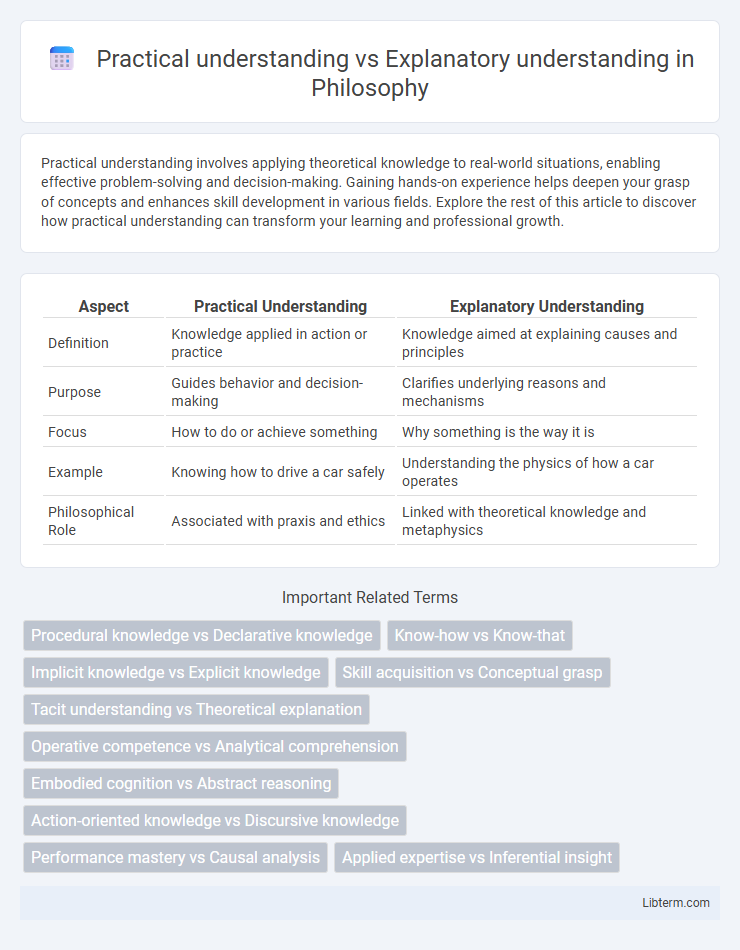Practical understanding involves applying theoretical knowledge to real-world situations, enabling effective problem-solving and decision-making. Gaining hands-on experience helps deepen your grasp of concepts and enhances skill development in various fields. Explore the rest of this article to discover how practical understanding can transform your learning and professional growth.
Table of Comparison
| Aspect | Practical Understanding | Explanatory Understanding |
|---|---|---|
| Definition | Knowledge applied in action or practice | Knowledge aimed at explaining causes and principles |
| Purpose | Guides behavior and decision-making | Clarifies underlying reasons and mechanisms |
| Focus | How to do or achieve something | Why something is the way it is |
| Example | Knowing how to drive a car safely | Understanding the physics of how a car operates |
| Philosophical Role | Associated with praxis and ethics | Linked with theoretical knowledge and metaphysics |
Defining Practical Understanding
Practical understanding refers to the ability to perform tasks efficiently by applying skills and knowledge in real-world contexts without necessarily articulating the underlying theories. It emphasizes hands-on experience and intuitive problem-solving rooted in practice. This type of understanding is crucial for mastering procedures and adapting techniques to specific situations.
What Is Explanatory Understanding?
Explanatory understanding involves grasping the underlying causes, principles, and mechanisms that explain why phenomena occur, rather than simply knowing how to perform tasks or apply techniques. It enables individuals to generate predictions, draw connections between concepts, and adapt knowledge to new contexts by comprehending the reasons behind observed patterns. This deep cognitive comprehension contrasts with practical understanding, which centers on procedural fluency and effective action without necessarily revealing the foundational explanations.
Key Differences Between Practical and Explanatory Understanding
Practical understanding involves applying knowledge to perform tasks effectively, emphasizing hands-on experience and skill acquisition, while explanatory understanding focuses on comprehending the underlying reasons and mechanisms behind phenomena. Key differences include practical understanding prioritizing context-specific actions and problem-solving, whereas explanatory understanding seeks to generalize principles and causality. Practical knowledge is often tacit and action-oriented, contrasting with the explicit, theory-driven nature of explanatory understanding.
Real-World Examples of Practical Understanding
Practical understanding emphasizes hands-on skills and the ability to apply knowledge in real-world scenarios, such as a mechanic diagnosing and repairing car engine issues through experience rather than theoretical explanations. This form of understanding is evident in professions like nursing, where practitioners rely on clinical intuition and practical skills to respond effectively to patient needs. Real-world examples highlight the value of learning by doing, demonstrating that practical skills often lead to immediate problem-solving success beyond theoretical comprehension.
Illustrations of Explanatory Understanding in Action
Explanatory understanding is demonstrated when individuals grasp the underlying causes and mechanisms of phenomena, enabling predictions and interventions beyond rote procedures. For instance, a doctor who comprehends the pathophysiology of a disease can tailor treatments effectively rather than solely following standard protocols. This depth of insight contrasts with practical understanding, which involves knowing how to perform tasks without necessarily understanding why they work.
Advantages of Practical Understanding
Practical understanding enables individuals to apply knowledge directly in real-world situations, enhancing problem-solving skills and adaptability. It promotes hands-on experience, leading to quicker decision-making and effective execution in various contexts such as technical tasks or everyday activities. This type of understanding also fosters intuition and expertise by engaging users actively rather than relying solely on theoretical explanations.
Benefits of Explanatory Understanding
Explanatory understanding enhances cognitive flexibility by enabling individuals to connect concepts and apply knowledge across diverse contexts, facilitating deeper problem-solving skills. It supports critical thinking through grasping underlying principles rather than merely performing tasks, leading to long-term retention and innovation. This form of understanding fosters informed decision-making, as it equips learners with the ability to reason about causes and implications beyond procedural knowledge.
Challenges in Balancing Both Types of Understanding
Balancing practical understanding and explanatory understanding presents challenges in aligning hands-on skills with deep conceptual knowledge, as practical expertise often emphasizes doing while explanatory understanding prioritizes why. This tension can result in fragmented learning, where individuals excel at tasks without grasping underlying principles, or possess theoretical insights that fail to translate into effective practice. Achieving synergy requires integrated educational approaches that simultaneously cultivate procedural proficiency and conceptual clarity to enhance overall comprehension and application.
When to Prioritize Practical Over Explanatory Understanding
Prioritize practical understanding when immediate application or problem-solving is required, as it emphasizes actionable knowledge and skill execution. In dynamic environments such as healthcare, engineering, or emergency response, practical understanding enables timely decisions and effective interventions. Explanatory understanding is more beneficial for long-term learning and theory development but can delay urgent responses when rapid comprehension and implementation are critical.
Integrating Practical and Explanatory Approaches for Deeper Insight
Integrating practical understanding, which emphasizes hands-on experience and application, with explanatory understanding, focused on underlying principles and theories, enhances problem-solving and decision-making capabilities. Practical insights provide contextual relevance, while explanatory knowledge offers a framework for predicting outcomes and adapting strategies in diverse scenarios. This synergy fosters a comprehensive grasp of complex phenomena, enabling more effective innovation and learning.
Practical understanding Infographic

 libterm.com
libterm.com